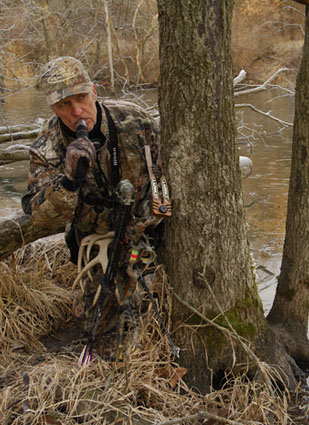Years ago when state agencies began to make fluorescent-orange clothing mandatory during gun seasons, hunters became alarmed. They worried that the bright orange color would make them more visible to deer, but subsequent research showed that deer did not see orange as we do. Around that same time a young bowhunter from Virginia named Jim Crumley introduced Trebark camo. No more solid-brown hunting coats! Trebark opened a floodgate that made our old hunting clothing obsolete.
 The secret to camo is not in the color — it’s in how well the pattern breaks up your form against the surroundings. |
Within a few years after Crumley’s innovation went to market, we had Realtree and Mossy Oak, and the camo crunch was on. Today we find camo for all habitats, from hardwoods to wetlands, from snow to the desert. And we find camo everywhere, from flashlights to fanny packs, arrows to ATVs, boots to bows. You name it, and we camouflage it.
The hype sounds great, but the real question is, does camouflage keep you hidden?
Let’s look at what we know about deer vision. We know that deer don’t see longer wavelengths well at all and reds and orange colors (which are in the longer wavelengths) are seen as shades of gray or yellow. We also know that deer have various adaptations that allow them to see extremely well at night. They have more rods in their retina, they have a tapetum lucidum behind the retina that reflects light through the retina, and they have a pupil three times wider than ours. Add these up and it’s scary how well deer see in low light.
The eyes of deer are farther apart than humans’, giving them the ability to cover a lot of ground with their eyes. But there is a weakness —research done at the University of Georgia shows that deer have 80 percent less acuity than we humans do. We have sharp central vision, but deer do not. When we focus on one spot (as you are now, reading these words), things in the periphery are blurred. Stop reading and focus on this word. Note, your vision gets blurrier and blurrier the farther it gets from the focused word. Being able to see that word very clearly is called visual acuity. When you go to the eye doctor and look at those “E” charts, they are really testing your visual acuity.
When we focus on one spot, we see that spot very clearly. Deer don’t. The reason is that we have an optic fovea that is located in the center of the retina, and it is packed with many, many cones. On the other hand, deer have a band of photo receptors across the retina, rather than one central spot. This allows a deer to scan a wide field of view all at once, without moving their eyes. Thus, when you have a deer standing at 80 yards facing in your direction, but not looking at you, they’ll have difficulty seeing you if you don’t move.
But if you do move, then they’ve got you spotted. Aha, finally we get to the need for camouflage clothes! The added rods that deer have, plus this band of photo receptors spread across the eye rather than in one spot, give deer an extraordinary ability to detect movement. It’s movement that does the hunter in, and it’s camo that allows you to move and get away with it.
OK, not totally. Movement even when wearing camo will get the attention of deer. We all know that. If you flip up your arm, even in camo, you increase the chance of being seen by a deer, even one that’s not looking directly at you. But, since deer have poor visual acuity, slow movements are harder for them to detect, and wearing camo helps.
Camo also reduces what I call the “blob phenomenon.” That 200 square inches of fluorescent orange that you are required to wear in gun season is a gray blob to deer. Large blobs of gray are not common to the woods, and when that blob moves, they pick it up. Camo helps to eliminate that because of the way it’s designed. No big blobs of color.
So, there you have it. Camo helps keep you hidden from deer, especially when you move.






